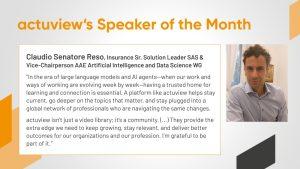by Roger Spitz
Risk is often treated as something we can model and measure. But what happens when uncertainty cannot be quantified? Deep uncertainty – where even the nature or likelihood of future states is contested – emerges in nonlinear systems shaped by complexity, unknowability, and interdependent dynamics. In such environments, shocks can accelerate through feedback loops and cascade systemically. This uncertainty is also asymmetrical: shocks and disruptions propagate unevenly across sectors, geographies, and stakeholders, amplifying systemic fragilities. As unprecedented events grow more frequent, the shortcomings of traditional risk models become starker.
Financial models thrive on data to price risk and calculate returns, yet the world is throwing curveballs – climate shifts, geoeconomic shocks, and all sorts of systemic disruptions – that defy historical patterns. Put simply, there is no data on the future.
This raises a hard question: “Have our traditional ‘predict and act’ models, built on mountains of data, stopped working?”
In a recent paper, “The future of risk and insurability in the era of systemic disruption, unpredictability and artificial intelligence,” published in the Journal of Operational Risk (Risk.Net), which we co-authored with Olivier Desbiey, Head of Foresight at AXA, we analyze the fragile nature of traditional risk management techniques in the face of frequent, high-impact shocks. We advocate for a new approach that treats disruption as systemic rather than episodic.
In an era defined by systemic disruption, radical unpredictability, and the rapid evolution of artificial intelligence, the classical distinction between risk and uncertainty – first articulated by Frank Knight and John Maynard Keynes – demands urgent reexamination.

- Risk – Most predictable: All parameters, outcomes, and likelihoods are knowable.
- Uncertainty – Some predictability: The nature of future events are known, but their probabilities are incalculable.
- Deep uncertainty – Least predictable: Stakeholders cannot agree on the nature of potential future states, let alone their probabilities. Possible outcomes are numerous and unknowable; as events occur, their interplay with other dynamic scenarios may be unimaginable.
When parameters are known, we can venture into meaningful modelling and predictions. In deep uncertainty, countless and interacting unknown variables hinder predictability.
For instance, in 2022, even the U.S. Treasury admitted to a fundamental lack of understanding regarding what it called “unanticipated” economic shocks. Reflecting new levels of unpredictability, in 2025, officials at the Cleveland Fed shifted from relying on a single base case to considering a range of distinct scenarios. Data has failed to anticipate many of the most disruptive developments of recent years.
So, if you can’t truly measure risk in future (or present) environments of deep uncertainty, would it be a far stretch to imagine resiliency-based insurance premiums?
Under systemic disruption, the most resilient insurance model isn’t about ‘PREDICT AND ACT.’ It’s evolving into ‘ANTICIPATE AND PREVENT’ – and ultimately, to ‘IMAGINE AND EMPOWER’, as in hypothetical ex ante insurance models.
The AAA Framework for Unpredictability
So, what paradigm shift is needed? To address complex dynamic environments of deep uncertainty, we propose the AAA Framework (Antifragile, Anticipatory, and Agility) as a novel approach for uncertainty management. This framework emphasizes imagination over prediction and prioritizes managing outcome amplitude over probability. This has critical implications for risk intelligence, insurability, and policy design in increasingly volatile and complex environments:
- Antifragile: Build foundations that are not only resilient to shocks but also strengthened by them, positioned to adapt and take advantage of any eventuality.
- Anticipatory: Improve the capacity for anticipatory thinking to navigate uncertainty, and go beyond short-termism, linear assumptions, and singular outcomes.
- Agility: Develop the agility to respond to whatever futures emerge, while reconciling our preferred vision of the futures with today’s unpredictable reality.

As “rare” becomes less rare, the AAA Framework allows better preparation for any future eventualities, while aligning decision-making to unleash impactful changes.
There is an increasing cost of assuming a predictable world, given the inverse relationship between predictability and uncertainty. The surprise we experience from disruption is inversely tied to our anticipatory thinking, willingness to question, and preparedness.
To operate in today’s unpredictable environment, we all need to be agile decision-makers. But ultimately, no matter how antifragile, anticipatory, or agile an organization becomes, the AAA Framework is only effective when activated by agency.
Agency is like an unexercised option: without action, it carries no value. As our understanding of these topics matures, the imperative is to translate it into action – exercising agency through effective and adaptive execution.
Note:
This Op-Ed is adapted from a paper, “The future of risk and insurability in the era of systemic disruption, unpredictability and artificial intelligence,” published in Journal of Operational Risk (Risk.Net) in June 2025.
About the Author:
Roger Spitz is a leading authority on systemic disruption and strategic foresight. Before founding the influential Disruptive Futures Institute in San Francisco, he served as Global Head of Technology M&A at BNP Paribas, advising on over $25 billion in transactions. Spitz is an expert advisor to the World Economic Forum’s Global Foresight Network. As President of Techistential, the preeminent foresight practice, Spitz advises CEOs, boards, and investors on strategy under uncertainty, anticipating disruptions, and sustainable value creation. A renowned expert on AI, Spitz coined the term ‘Techistentialism’ and is a sought-after thought leader on the future of strategic decision-making and artificial intelligence. Spitz serves on multiple boards, and is a bestselling author of five books, including the award-winning Disrupt With Impact: Achieve Business Success in an Unpredictable World and acclaimed four-volume series The Definitive Guide to Thriving on Disruption. Spitz’s frameworks are adopted globally and feature in leading publications. His recent paper challenges the legacy risk models: “The future of risk and insurability in the era of systemic disruption, unpredictability and artificial intelligence” Journal of Operational Risk (Risk.Net).
Join Roger Spitz for his talk on Risk Management in Times of Global Uncertainty at CERAVISION 2025 on October 28 online. Register now for free.






